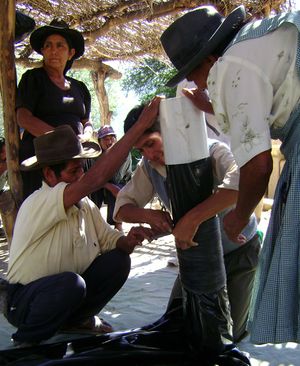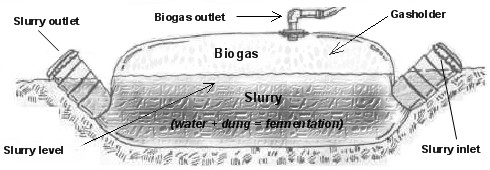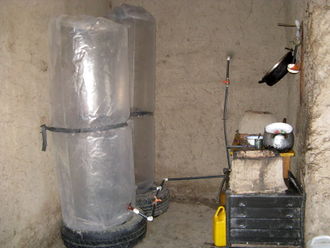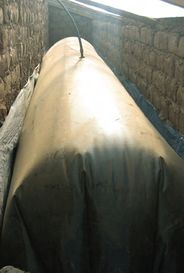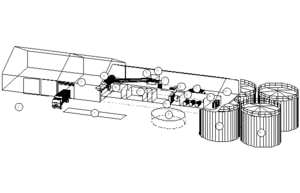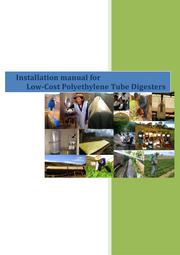Knowledge fuels change - Support energypedia!
For over 10 years, energypedia has been connecting energy experts around the world — helping them share knowledge, learn from each other, and accelerate the global energy transition.
Today, we ask for your support to keep this platform free and accessible to all.
Even a small contribution makes a big difference! If just 10–20% of our 60,000+ monthly visitors donated the equivalent of a cup of coffee — €5 — Energypedia would be fully funded for a whole year.
Is the knowledge you’ve gained through Energypedia this year worth €5 or more?
Your donation keeps the platform running, helps us create new knowledge products, and contributes directly to achieving SDG 7.
Thank you for your support, your donation, big or small, truly matters!
Low-Cost Polyethylene Tube Digester
Overview
There are different types of small scale biogas digesters. Some of the biogas digesters are summarized below:
- Fixed-dome Plants
- Floating-drum Plants
- Low-Cost Polyethylen Tube Digester
- Balloon Plants
The table below gives a first comparision of the different types.
Factors |
Fixed dome |
Floating drum |
Tubular design |
Plastic containers |
|---|---|---|---|---|
Gas storage |
Internal Gas storage up to 20 m³ (large) |
Internal Gas storage drum size (small) |
Internal eventually external plastic bags |
Internal Gas storage drum sizes (small) |
Gas pressure |
Between 60 and 120 mbar |
Upto 20 mbar |
Low, around 2 mbar |
Low around 2mbar |
Skills of contractor |
High; masonry, plumbing |
High; masonry, plumbing, welding |
Medium; plumbing |
Low; plumbing |
Availability of Material |
yes |
yes |
yes |
yes |
Durability |
Very high >20 years |
High; drum is weakness |
Medium; Depending on chosen liner |
Medium
|
Agitation |
Self agitated by Biogas pressure |
Manual steering |
Not possible; plug flow type |
Evtl Manual steering |
Sizing |
6 to 124 m³ digester vol |
Up to 20 m³ |
Combination possible |
Up to 6 m³ digester vol |
Methane emission |
High |
Medium |
Low |
Medium |
Low-Cost Polyethylene Tube Digester
In the case of the Low-Cost Polyethylene Tube Digester model which is applied in Bolivia (Peru, Ecuador, Colombia, Centro America and Mexico), the tubular polyethylene film (two coats of 300 microns) is bended at each end around a 6 inch PVC drainpipe and is wound with rubber strap of recycled tire-tubes. With this system a hermetic isolated tank is obtained (figure td1 ).
| One of the 6" PVC drainpipes serves as inlet and the other one as the outlet of the slurry. In the tube digester finally, a hydraulic level is set up by itself, so that as much quantity of added prime matter (the mix of dung and water) as quantity of fertilizer leave by the outlet. Because the tubular polyethylene is flexible, it is necessary to construct a "cradle" which will accommodate the reaction tank, so that a trench is excavated (picture td3). | ||
Gasholder and Gas Storage Reservoir
The capacity of the gasholder corresponds to 1/4 of the total capacity of the reaction tube (figure td1). To overcome the problem of low gas flow rates, two 200 microns tubular polyethylene reservoirs are installed close to the kitchen, which gives a 1,3 m³ additional gas storage (picture td4).
To contrast these simple biogas plants, figure 2 gives an impression about dimensions of industrial plants which are, for example, built in Europe.
Installation Manual for Low Cost Polyethylene Biogas Digester
Experience with Polythylene Biogas Digester (PBD)
To read about the experiences of deploying Polyethylene biogas digester, please see the article on
Variation Tyre Tube Household Digester
Further Information
- Biogas portal on energypedia
- Experience with Polyethylene Biogas Digester (PBD)
- Low cost polyethylene tube digester in Rwanda
References
This article is a continuation of the article, Types of Biogas Digesters and Plants. For questions regarding the article, please contact the authors of the article, Types of Biogas Digesters and Plants.

